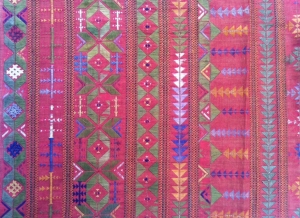The desired pattern of Suf embroidery is not normally drawn onto the ground cloth, but built up around a series of triangles and diamonds. Often small pieces of glass or mirror (shisha) are included in the designs.
This form of embroidery was traditionally used to decorate a bride’s collection of clothing and part of her family’s gifts to the fiancé’s family. Suf embroidery was also known from neighbouring Sindh, in modern Pakistan. In 1972, and as a direct result of the India-Pakistan War (1971), many Hindu communities, including embroiderers, migrated from Sindh in (Muslim) Pakistan to neighbouring (Indian) Kutch, thus introducing new elements to Suf embroidery in Kutch.
See also: Kala Raksha Trust; Khaarek.
Sources:
- FRATER, Judy (1995). Threads of Identity: Embroidery and Adornment of the Nomadic Rabaris, Ahmedabad: Mapin.
- LITTRELL, Mary A. and Judy FRATER (2013). 'Artisan Enterprise, Cultural Property, and the Global Market', in (eds.) Sandy Black, Amy de la Haye, Joanne Entwistle, Agnès Rocamora, Regina Root and Helen Thomas. The Handbook of Fashion Studies, London: Bloomsbury, pp. 371-390.
Digital sources:
- SABNANI, Nina and Judy FRATER (2012). Art as identity: Social mobility through textiles in Kutch, Industrial Design Centre, Bombay, India, pp. 1-8.
- www.kala-raksha.org (retrieved 14 March 2017)
TRC online catalogue (retrieved 14 March 2017).
GVE

